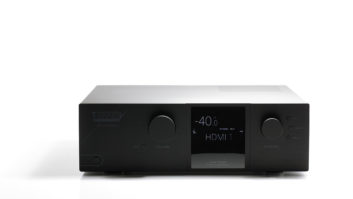Deciphering The Alphabet Soup Of Digital Audio Format Acronyms
A lot of high-end audiophile AV clients have become obsessed with adding turntables and tube amplifiers to their home listening systems, but digital will still be the fundamental format of the future, and it has plenty of nuance, too, in the form of audio codecs.
Audio codecs are an alphabet soup of arcane and esoteric three- and four-letter acronyms, most of which rarely make it beyond the laboratory. But while the two big players in that domain, the various MP formats–with MP3 being the dominant by a landslide–and the AAC codec favored by Apple, overshadow their multitudinous siblings, the entire array of audio codecs, upon which the file-based music industry of the last decade has been largely predicated, are in constant flux. Music files have drawn disdain from audiophiles for years, and even casual listeners can hear the difference between a compressed and an uncompressed file. But that’s changing. For instance, Apple recently developed guidelines and tools intended to help recording and mastering engineers and has adapted its downconversion process to the AAC format that iTunes uses to be able to accept 24-bit/96-kHz master files. When you start with higher resolution, the downsampled end result will also be better. That makes this a good time to look at the file-based universe of music reproduction from the AV systems integrator’s point of view.
Thank You Beats
Much of the activity in the digital music domain has come about from a relatively recent trend toward higher quality audio. Culturally, that shift is most visible on the streets, as teens and Millennials toss away their earbuds and cover up with over-the-ear closed-cup headphones. The Beats brand, promulgated by rapper/ entrepreneur Dr. Dre and Interscope label chief Jimmy Iovine, has rapidly garnered market share, and even professional audio brands like Audio- Technica and Sennheiser have been quick to leverage their audiophile cred and get consumer products to market that offer improved frequency response and greater bandwidth than earbuds ever could. But a flight to quality is also evident at the molecular level, most notably Apple’s abandonment of DRM-protected AAC files in 2009, which let those music files better utilize the newly freed-up bandwidth of the format for music data instead of copy protection.
Formats
There are three major format food groups when it comes to file formats and codecs: uncompressed, lossless, and lossy. Raw PCM files and .wav files, used on Compact Discs, can be used with variable combinations of sampling and bit rates and are the main uncompressed types, used for archival as well as consumer applications. The lossless category has the largest number of candidates, including FLAC, ATRAC Advanced Lossless, Apple Lossless (filename extension m4a), MPEG-4 SLS, MPEG-4 ALS, MPEG-4 DST, and Windows Media Audio Lossless (WMA Lossless). Formats with lossy compression, include garden-variety MP3, Vorbis, Musepack, AAC, ATRAC, and Windows Media Audio Lossy (WMA lossy). These are listed in descending order of data size–lossless and lossy file formats eliminate progressively larger amounts of data and different types of data to become smaller to store and faster to transfer.
While having to deal with far less data and file sizes than video, audio codecs nonetheless have their share of complexities. For instance, Apple made its lossless audio format an open source in late 2011, which will allow users to view and change the code for use in their own software and tools. The adapted format, known as Apple Lossless Audio Codec or ALAC, lets users rip tracks from a CD–still the most prevalent source of music files besides downloading–into compressed files without reduction in quality, although the resulting files are still substantially larger than the more common but more highly compressed MP3, AAC, and WMA formats. That’s also what FLAC (Free Lossless Audio Codec) files can do, and they do it royaltyfree, but are not supported by Apple’s portable devices.
Getting CD-type .wav files imported into Applesupported devices has gotten easier and more efficient, but glitches can arise. One of those is the annoying habit of Apple Lossless-transcoded files becoming corrupted when accompanying album artwork is applied to them manually, which is what some users will do when iTunes can’t find the appropriate graphics. Worse, the glitch is often random.

Audio codecs are also evolutionarily dynamic, with new ones arriving all the time.
Audio codecs are also evolutionarily dynamic, with new ones arriving all the time. For instance, a next-generation codec, called CELT (Constrained Energy Lapped Transform), was recently released by the Xiph.Org Foundation, creator of the royalty-free Vorbis audio encoding technology that competes with codecs such as MP3 and AAC that come with patent royalty fees. CELT is designed to use less processing power than Vorbis to decode and to offer lower latency–5 milliseconds–from when data starts arriving to when audio is decoded, versus the tenth of a second that Vorbis offers. CELT’s planned successor codec format, known appropriately as Ghost for now, will operate closer to Vorbis’ speed but will offer dynamic bitrates, improving sound on lower bandwidth environments and adding quality on high-bandwidth connections.
Some of these codecs may seem hopelessly arcane compared with the familiar and highly utilitarian MP3 types and .wav formats, but the number and type of entities seeking to add music to their service palette are looking for technological differentiation and these esoteric codecs offer exactly that. Google, for one, has been backing a video codec from the Xiph.Org Foundation, which has been helping move Vorbis and its relatives further into the mainstream of codec-world. And new codecs are being introduced at the high end of the spectrum. For instance, the Fraunhofer Institute, which brought the world the MP3 in the first place, in 2010 introduced its HD-AAC codec, which can keep the bandwidth and bit structure of a 96-kHz/24-bit track intact and deliver it at a bit rate of about 700 kbps, approximately half the bit rate of the original recording and considerably higher than the 256 kbps of the higher-resolution files available on the Apple iTunes web store.
High-Definition Audio Content
Music lovers have a greater depth of choice when it comes to HD music digitally delivered these days. As the CD continues its long fade and the overly optimistic so-called high-definition disc formats like SACD and DVD-Audio become museum pieces, several service providers have stepped up to offer high-def music tracks virtually. HDtracks, the high-resolution online sales venture by audiophile jazz record label Chesky Records that launched in 2008, now distributes highresolution tracks from both Warner Music Group and Universal Music Group archives that includes the label’s jazz standbys as well as remastered tracks from mostly legacy artists including the Rolling Stones, the Kinks, and Elton John. HDtracks offers a high-quality music download service using a variety of file types. These include AIFF CD-quality uncompressed music files; FLAC CD-quality “lossless” compressed music files with sonic quality on par with that of AIFF files but that can be downloaded faster (but that are not compatible with Windows Media Player, iTunes or the iPod); 320-kbps MP3 files that offer universal compatibility at a higher resolution than the more typical 128k files; and 96-kHz/24-bit and 88.2-kHz/24-bit FLAC, which are DVD-Audio-quality music files aimed at the ultra-audiophile market sliver. All files include metadata such as album graphics, liner notes and other information (supplied by the original labels) and can be configured with values ranging from 192-kHz/24-bits through the 44.1-kHz/16-bit format of standard CDs.
The high-res music sector has had few successes in the past. The technology has been around a while– Apple Lossless (aka ALAC) was introduced in 2004– and high-res music distribution ventures have been tried before. Most notably, Music Giants launched in 2007, selling lossless and 24-bit digital albums, using either Windows WMA lossless HD stereo files for $1.29 per song, or Super HD Audio in stereo or surround formats, which are file-based versions of SACD and DVD-A discs that were priced around $20 apiece. The company had a limited catalog but did have titles from major recording artists including the Rolling Stones, Miles Davis, Big Star, Pink Floyd, and Art Blakey. However, Music Giants came on the scene with WMA9 files just as Apple’s iPod and iTunes products were taking over the world and Microsoft’s Zune was headed toward punch-line status. Further, the Music Giants site was limited to the use of Internet Explorer and required Windows XP or Vista operating systems, and the SACD files were huge–a three-minute song took up about 50MB.
Music Giants shuttered in less than two years but others have persevered. Mark Waldrep’s Los Angeles-based AIX label has specialized in highresolution music since its inception in 2001. In 2009, Waldrep created iTrax, an online distribution service that offers WM Pro, DTS, and Dolby Digital versions of titles of artists he records at 96/24 in PCM. Waldrep says that the HD equation between video and audio remains disconnected: “People embraced flat-panel displays with high-definition video but for some reason we haven’t been able to make that happen for audio yet.”
Waldrep says that while the stew of codecs can seem confusing, he recommends steering high-end clients to the FLAC format and using a computerbased music server such as an Apple Mac Mini. “For $3,000 or less, with a good DAC, you can kick the doors down on CD quality using a server and an upscale file format like FLAC,” he said. Furthermore, he suggests this type of system as a backstop against the rise of streaming, where the audio quality isn’t limited by the size of he file but rather by the bandwidth of the transfer pipe.
“Hooking into Pandora or Spotify as a discovery channel for new music is great,” Waldrep said. “But the [sonic] quality level simply isn’t going to be there, because it can’t.”
For all the grumbling by audiophiles about digital music in general and more recently about streaming music, it cannot be argued that consumers of all types have been seduced by the convenience of digital delivery. “To many listeners, even high-end ones, the codec is secondary,” noted David Frangioni, owner of Audio One in Miami. “What people think about is the user interface.”
Frangioni said that the biggest practical problem he faces is that the profusion of codecs and file formats and the varying ways that CDs and analog music are brought into home systems has created a huge disparity in levels between tracks, which can be annoying as users move between songs on different formats. He tries to level-match tracks as he adds them to systems, trying to avoid having to add gain using the system’s pre-amp, which adds noise. In some installations he’s included a +/-3dB attenuation/boost button so that users can quickly adjust levels between particularly mismatched track levels.
“The real solution is using the best-quality source you can get at a high level [of volume],” Frangioni suggested. And in the alphabet soup of digital codecs and file formats, that might be the best advice of all.
Dan Daley is a freelance writer in Nashville, TN.





